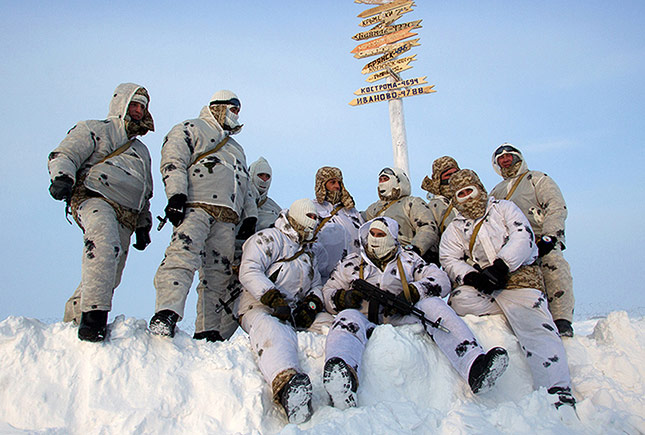Like ‘Ice Station
Zebra’… For Real
Russian paratroopers leap headlong into the slipstream of a transport aircraft disgorging them over the vast icy wastes of the North Pole; tumbling head over heel, drogue chutes trailing behind, one-by-one the soldiers’ main parachutes deploy. They glide down to land on a drifting ice floe next to a research station.
This isn’t a scene from the late 1960s movie ‘Ice Station Zebra’ that I saw at the cinema when I was a kid, but happened a day or two ago and was filmed by highly skilled cameramen and pumped out as the latest example of Russian military derring-do propaganda.

Russian troops pose for a group shot on the Arctic ice. Photo: Russian defence ministry.
Russia is currently boosting its presence in the Arctic, progressing rapidly via commissioning of new nuclear-powered submarines, flights by far-ranging aircraft, plus deployments of paratroopers and naval infantry. The Kremlin is staking a claim to vast natural resources on the seabed under the ice. It is aiming to dominate the Arctic Ocean just like the Chinese on the other side of the world are laying claim to the entire South China Sea. It is yet another illustration of the uncanny ability of fact to mimic fiction.

The poster for the movie of ‘Ice Station Zebra’. Image: Metro-Goldwyn-Mayer.
For those scenes of Soviet paratroopers raining down on the North Pole in the movie ‘Ice Station Zebra’, must have implanted themselves as powerfully in the brain of young Russians as much as they took hold of my imagination. Now they have turned Hollywood’s iconography back on the West by presenting a spectacular real-life adventure to show how Russia’s paratroopers can achieve extraordinary things even today, and for real.
Of course, as soon as Moscow reset its relationship with the West to one of overt rivalry, it was inevitable games of military one upmanship would unfold. The story behind‘ Ice Station Zebra’, as explained in my book ‘Hunter Killers’ (and very briefly in a previous post on this site) was even more fantastic than both the Alistair MacLean novel, published in 1963, and the 1968 movie.
In recent years it has emerged that the CIA in May 1962 was involved in exploits to counter Soviet listening stations on the Polar ice. Even if he did not know precise details of the CIA mission, MacLean certainly did plenty of research into under-ice operations by submarines and the espionage roles of ‘research stations’ on ice floes.
In real life, the USA’s Office of Naval Research, Defense Intelligence Agency and CIA put together ‘Operation Coldfeet’. This involved two ‘intelligence collectors’ being parachuted onto the ice close to a drifting, and recently abandoned, Soviet research station.
The Russians had conducted an evacuation because they believed the ice would soon crush it. After seven days collecting intelligence the two Americans were picked up in breath-taking fashion by a specially converted former B-17 bomber. Using a so-called ‘Skyhook’ it plucked them and their intelligence goodies from the ice and reeled them in.
The CIA recently revealed they brought home ‘valuable information’ on how the Soviet Union was utilising its scientific research stations. ‘The team found evidence of advanced acoustical systems research to detect under-ice US submarines,’ a CIA document reveals, ‘and efforts to develop Arctic anti-submarine warfare techniques.
And today, never mind the macho exploits of Russian paratroopers, the most interesting game of all in the so-called new Cold War, will be what transpires beneath the ice, both in terms of Russia exploiting oil and gas reserves and potentially a fresh face-off between the submarines of the West and the Russian Navy.

A US Navy nuclear-powered submarine surfaces through ice in the Arctic Ocean. Photo: US Navy.
Just a few months ago the US Navy sent a cutting edge nuclear-powered attack submarine, USS Seawolf, on a voyage under the North Pole. As defence writer and analyst David Axe wrote on his web site and in a recent edition of the magazine I run the Seawolf departed Bremerton in August 2013 and then four weeks later suddenly turned up in a Norwegian port. Axe noted: ‘it seems Seawolf travelled to Norway along a path rarely taken by any vessel: Underneath the Arctic ice. The US Navy doesn’t like to talk about its submarines. After all, a sub’s biggest advantage is its stealth.’ And Seawolf’s main mission is intelligence gathering. The Russians can beat their chests and show off as much as they like by parachuting onto an ice floe at the North Pole, but another game is afoot out of sight. And it is far stranger, and more serious, than any fiction.
Comments
Comments are closed.